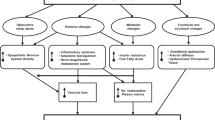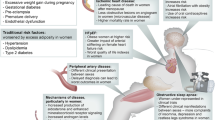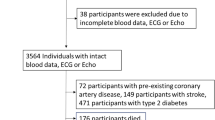Abstract
Obesity is associated with an increased risk of heart failure. Apparently healthy obese individuals can, however, exhibit subclinical left ventricular dysfunction. The use of myocardial imaging techniques to detect this subclinical change could have important management implications with respect to initiating prophylactic therapy. In this Review, we evaluate possible pharmacologic and nonpharmacologic strategies for treating obesity cardiomyopathy in the context of currently understood mechanisms, including myocardial remodeling and small vessel disease, and more speculative mechanisms such as insulin resistance, and activation of the renin–angiotensin–aldosterone and sympathetic nervous systems.
Key Points
-
Obesity is associated with an increased risk of heart failure
-
Subclinical left ventricular dysfunction can be detected with noninvasive cardiac imaging techniques such as echocardiography (including tissue Doppler imaging, backscatter and strain imaging), MRI, CT and nuclear ventriculography
-
Therapeutic approaches include weight control by dietary intervention and exercise, and bariatric surgery for the morbidly obese
-
Renin–angiotensin–aldosterone system antagonists, β-blockade and insulin sensitizers are potential therapeutic options for individuals with obesity cardiomyopathy
This is a preview of subscription content, access via your institution
Access options
Subscribe to this journal
Receive 12 print issues and online access
$209.00 per year
only $17.42 per issue
Buy this article
- Purchase on Springer Link
- Instant access to full article PDF
Prices may be subject to local taxes which are calculated during checkout



Similar content being viewed by others
References
Hunt SA et al. (2005) ACC/AHA 2005 Guideline update for the diagnosis and management of chronic heart failure in the adult—summary article: a report of the American College of Cardiology/American Heart Association Task Force on Practice Guidelines (Writing Committee to Update the 2001 Guidelines for the Evaluation and Management of Heart Failure). J Am Coll Cardiol 46: 1116–1143
Swedberg K et al. (2005) Guidelines for the diagnosis and treatment of chronic heart failure—executive summary (update 2005): The Task Force for the Diagnosis and Treatment of Chronic Heart Failure of the European Society of Cardiology. Eur Heart J 26: 1115–1140
McDonagh TA et al. (1997) Symptomatic and asymptomatic left-ventricular systolic dysfunction in an urban population. Lancet 350: 829–833
Dewey M et al. (2006) Evaluation of global and regional left ventricular function with 16-slice computed tomography, biplane cineventriculography, and two-dimensional transthoracic echocardiography: comparison with magnetic resonance imaging. J Am Coll Cardiol 48: 2034–2044
Danias PG et al. (2003) Cardiac structure and function in the obese: a cardiovascular magnetic resonance imaging study. J Cardiovasc Magn Reson 5: 431–438
Vasan RS et al. (1997) Left ventricular dilatation and the risk of congestive heart failure in people without myocardial infarction. N Engl J Med 336: 1350–1355
Wang TJ et al. (2003) The epidemiology of “asymptomatic” left ventricular systolic dysfunction: implications for screening. Ann Intern Med 138: 907–916
Garcia MJ et al. (1998) New Doppler echocardiographic applications for the study of diastolic function. J Am Coll Cardiol 32: 865–875
Wong CY et al. (2004) Alterations of left ventricular myocardial characteristics associated with obesity. Circulation 110: 3081–3087
Wong CY et al. (2006) Association of subclinical right ventricular dysfunction with obesity. J Am Coll Cardiol 47: 611–616
Marwick TH (2004) Should we be evaluating the ventricle or the myocardium? Advances in tissue characterization. J Am Soc Echocardiogr 17: 168–172
Wong CY et al. (2006) Effect of weight loss due to lifestyle intervention on subclinical cardiovascular dysfunction in obesity (body mass index >30 kg/m2). Am J Cardiol 98: 1593–1598
Alpert MA et al. (1989) Effect of exercise and cavity size on right ventricular function in morbid obesity. Am J Cardiol 64: 1361–1365
Alaud-din A et al. (1990) Assessment of cardiac function in patients who were morbidly obese. Surgery 108: 809–818
Laukkanen JA et al. (2004) The predictive value of cardiorespiratory fitness for cardiovascular events in men with various risk profiles: a prospective population-based cohort study. Eur Heart J 25: 1428–1437
Wang TJ et al. (2004) Impact of obesity on plasma natriuretic peptide levels. Circulation 109: 594–600
Taylor JA et al. (2006) B-type natriuretic peptide and N-terminal pro B-type natriuretic peptide are depressed in obesity despite higher left ventricular end diastolic pressures. Am Heart J 152: 1071–1076
Wong CY and Marwick TH (2007) Obesity cardiomyopathy: pathogenesis and pathophysiology. Nat Clin Pract Cardiovasc Med 4: 436–443
Mertens IL and Van Gaal LF (2000) Overweight, obesity, and blood pressure: the effects of modest weight reduction. Obes Res 8: 270–278
Tuomilehto J et al. (2001) Prevention of type 2 diabetes mellitus by changes in lifestyle among subjects with impaired glucose tolerance. N Engl J Med 344: 1343–1350
Keenan KP et al. (2005) Diabesity: a polygenic model of dietary-induced obesity from ad libitum overfeeding of sprague-dawley rats and its modulation by moderate and marked dietary restriction. Toxicol Pathol 33: 650–674
MacMahon SW et al. (1986) The effect of weight reduction on left ventricular mass: a randomized controlled trial in young, overweight hypertensive patients. N Engl J Med 314: 334–339
Marfella R et al. (2004) Effect of weight loss on cardiac synchronization and proinflammatory cytokines in premenopausal obese women. Diabetes Care 27: 47–52
DasGupta P et al. (1992) Improvement in left ventricular function after rapid weight loss in obesity. Eur Heart J 13: 1060–1066
Corrao S et al. (2000) Effects of a short-term hypoenergetic diet on morphofunctional left ventricular parameters in centrally obese subjects: an echocardiographic study. Panminerva Med 42: 123–129
Willens HJ et al. (2005) Effects of weight loss after gastric bypass on right and left ventricular function assessed by tissue Doppler imaging. Am J Cardiol 95: 1521–1524
Todaka K et al. (1997) Impact of exercise training on ventricular properties in a canine model of congestive heart failure. Am J Physiol 272: H1382–H1390
Belardinelli R et al. (1995) Exercise training improves left ventricular diastolic filling in patients with dilated cardiomyopathy: clinical and prognostic implications. Circulation 91: 2775–2784
Wirth A and Kroger H (1995) Improvement of left ventricular morphology and function in obese subjects following a diet and exercise program. Int J Obes Relat Metab Disord 19: 61–66
Hinderliter A et al (2002) Reduction of left ventricular hypertrophy after exercise and weight loss in overweight patients with mild hypertension. Arch Intern Med 162: 1333–1339
Ploug T et al. (1998) Analysis of GLUT4 distribution in whole skeletal muscle fibers: identification of distinct storage compartments that are recruited by insulin and muscle contractions. J Cell Biol 142: 1429–1446
James WP et al. (2000) Effect of sibutramine on weight maintenance after weight loss: a randomised trial. STORM Study Group. Sibutramine Trial of Obesity Reduction and Maintenance. Lancet 356: 2119–2125
Jordan J et al. (1995) Reduction of weight and left ventricular mass with serotonin uptake inhibition in obese patients with systemic hypertension. Am J Cardiol 75: 743–744
Godoy-Matos A et al. (2005) Treatment of obese adolescents with sibutramine: a randomized, double-blind, controlled study. J Clin Endocrinol Metab 90: 1460–1465
Alexander JK and Peterson KL (1972) Cardiovascular effects of weight reduction. Circulation 45: 310–318
Alpert MA et al. (1995) Effect of weight loss on left ventricular diastolic filling in morbid obesity. Am J Cardiol 76: 1198–1201
Sjostrom CD et al. (1999) Reduction in incidence of diabetes, hypertension and lipid disturbances after intentional weight loss induced by bariatric surgery: the SOS Intervention Study. Obes Res 7: 477–484
Karason K et al. (1997) Effects of obesity and weight loss on left ventricular mass and relative wall thickness: survey and intervention study. BMJ 315: 912–916
Alpert MA et al. (1985) Effect of weight loss on cardiac chamber size, wall thickness and left ventricular function in morbid obesity. Am J Cardiol 55: 783–786
Alpert MA et al. (1994) Effect of weight loss on left ventricular mass in nonhypertensive morbidly obese patients. Am J Cardiol 73: 918–921
Alpert MA et al. (1993) Factors influencing left ventricular systolic function in nonhypertensive morbidly obese patients, and effect of weight loss induced by gastroplasty. Am J Cardiol 71: 733–737
Kanoupakis E et al. (2001) Left ventricular function and cardiopulmonary performance following surgical treatment of morbid obesity. Obes Surg 11: 552–558
Karason K et al. (2000) Relief of cardiorespiratory symptoms and increased physical activity after surgically induced weight loss: results from the Swedish Obese Subjects study. Arch Intern Med 160: 1797–1802
Alpert MA et al. (1995) Relation of duration of morbid obesity to left ventricular mass, systolic function, and diastolic filling, and effect of weight loss. Am J Cardiol 76: 1194–1197
Licata G et al. (1992) Left ventricular function response to exercise in normotensive obese subjects: influence of degree and duration of obesity. Int J Cardiol 37: 223–230
Alpert MA et al. (1997) Cardiac morphology and left ventricular function in normotensive morbidly obese patients with and without congestive heart failure, and effect of weight loss. Am J Cardiol 80: 736–740
Klein S et al. (2004) Absence of an effect of liposuction on insulin action and risk factors for coronary heart disease. N Engl J Med 350: 2549–2557
Himeno E et al. (1996) Weight reduction regresses left ventricular mass regardless of blood pressure level in obese subjects. Am Heart J 131: 313–319
Tuck ML et al (1981) The effect of weight reduction on blood pressure, plasma renin activity, and plasma aldosterone levels in obese patients. N Engl J Med 304: 930–933
Greenberg B et al. (1995) Effects of long-term enalapril therapy on cardiac structure and function in patients with left ventricular dysfunction: results of the SOLVD echocardiography substudy. Circulation 91: 2573–2581
Vuorinen-Markkola H and Yki-Jarvinen H (1995) Antihypertensive therapy with enalapril improves glucose storage and insulin sensitivity in hypertensive patients with non-insulin-dependent diabetes mellitus. Metabolism 44: 85–89
Henriksen EJ et al. (1999) ACE inhibition and glucose transport in insulin resistant muscle: roles of bradykinin and nitric oxide. Am J Physiol 277: R332–R336
Feuerstein GZ et al. (1997) Protective effects of carvedilol in the myocardium. Am J Cardiol 80: 41L–45L
Panchal AR et al. (1998) Beta-receptor blockade decreases carnitine palmitoyl transferase I activity in dogs with heart failure. J Card Fail 4: 121–126
Sharma AM et al. (2001) Hypothesis: Beta-adrenergic receptor blockers and weight gain: a systematic analysis. Hypertension 37: 250–254
Poole-Wilson PA et al. (2003) Comparison of carvedilol and metoprolol on clinical outcomes in patients with chronic heart failure in the Carvedilol Or Metoprolol European Trial (COMET): randomised controlled trial. Lancet 362: 7–13
Al Hesayen A et al. (2005) Selective versus nonselective beta-adrenergic receptor blockade in chronic heart failure: differential effects on myocardial energy substrate utilization. Eur J Heart Fail 7: 618–623
Zhou YT et al. (2000) Lipotoxic heart disease in obese rats: implications for human obesity. Proc Natl Acad Sci USA 97: 1784–1789
Golfman LS et al. (2005) Activation of PPARgamma enhances myocardial glucose oxidation and improves contractile function in isolated working hearts of ZDF rats. Am J Physiol Endocrinol Metab 289: E328–E336
Raji A et al. (2003) Rosiglitazone improves insulin sensitivity and lowers blood pressure in hypertensive patients. Diabetes Care 26: 172–178
Wang TD et al. (2004) Effects of rosiglitazone on endothelial function, C-reactive protein, and components of the metabolic syndrome in nondiabetic patients with the metabolic syndrome. Am J Cardiol 93: 362–365
Ren J et al. (1999) Metformin but not glyburide prevents high glucose-induced abnormalities in relaxation and intracellular Ca2+ transients in adult rat ventricular myocytes. Diabetes 48: 2059–2065
Dutta K et al. (2001) Cardiomyocyte dysfunction in sucrose-fed rats is associated with insulin resistance. Diabetes 50: 1186–1192
Acknowledgements
The authors would like to acknowledge the National Health and Medical Research Council, Canberra, Australia for a Centers of Clinical Research Excellence Award and postgraduate research scholarship.
Author information
Authors and Affiliations
Corresponding author
Ethics declarations
Competing interests
C Wong declared no competing interests.
TH Marwick receives grant support from GE Healthcare and Philips Medical Systems, but unrelated to this topic.
Rights and permissions
About this article
Cite this article
Wong, C., Marwick, T. Obesity cardiomyopathy: diagnosis and therapeutic implications. Nat Rev Cardiol 4, 480–490 (2007). https://doi.org/10.1038/ncpcardio0964
Received:
Accepted:
Issue Date:
DOI: https://doi.org/10.1038/ncpcardio0964
This article is cited by
-
Weighing in on heart failure: the potential impact of bariatric surgery
Heart Failure Reviews (2022)
-
Obese cardiogenic arrest survivors with significant coronary artery disease had worse in-hospital mortality and neurological outcomes
Scientific Reports (2020)
-
ACE-inhibition induces a cardioprotective transcriptional response in the metabolic syndrome heart
Scientific Reports (2018)
-
A Population-Based Study of Early Postoperative Outcomes in Patients with Heart Failure Undergoing Bariatric Surgery
Obesity Surgery (2018)
-
Associations of childhood and adult obesity with left ventricular structure and function
International Journal of Obesity (2017)



